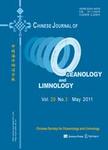Regional hard coral distribution within geomorphic and reef flat ecological zones determined by satellite imagery of the Xisha Islands,South China Sea
Regional hard coral distribution within geomorphic and reef flat ecological zones determined by satellite imagery of the Xisha Islands, South China Sea作者机构:State Key Laboratory of Resources and Environmental Information SystemInstitute of Geographic Sciences and Natural Resources ResearchChinese Academy of SciencesBeijing 100101China Collaborative Innovation Center of South China Sea StudiesNanjing 210093China University of Chinese Academy of SciencesBeijing 100049China Key Laboratory of Marginal Sea GeologySouth China Sea Institute of OceanologyChinese Academy of SciencesGuangzhou 510301China Key Laboratory of Hydrography and Cartography of PLADepartment of Hydrography and CartographyDalian Naval AcademyDalian 116018China
出 版 物:《Chinese Journal of Oceanology and Limnology》 (中国海洋湖沼学报(英文版))
年 卷 期:2017年第35卷第3期
页 面:501-514页
核心收录:
学科分类:0710[理学-生物学] 0908[农学-水产] 07[理学] 0707[理学-海洋科学] 0815[工学-水利工程] 071004[理学-水生生物学]
基 金:Supported by the National High Technology Research and Development Program of China(863 Program)(No.2012AA12A406) the National Natural Science Foundation of China(No.41271409) the National Science and Technology Major Project(No.00-Y30B15-9001-14/16-5)
主 题:coral reef geomorphic zone remote sensing Xisha Islands South China Sea
摘 要:Coral reefs in the Xisha Islands (also known as the Paracel Islands in English), South China Sea, have experienced dramatic declines in coral cover. However, the current regional scale hard coral distribution of geomorphic and ecological zones, essential for reefs management in the context of global warming and ocean acidification, is not well documented. We analyzed data from field surveys, Landsat-8 and GF-1 images to map the distribution of hard coral within geomorphic zones and reef fiat ecological zones. In situ surveys conducted in June 2014 on nine reefs provided a complete picture of reef status with regard to live coral diversity, evenness of coral cover and reef health (live versus dead cover) for the Xisha Islands. Mean coral cover was 12.5% in 2014 and damaged reefs seemed to show signs of recovery. Coral cover in sheltered habitats such as lagoon patch reefs and biotic dense zones of reef flats was higher, but there were large regional differences and low diversity. In contrast, the more exposed reef slopes had high coral diversity, along with high and more equal distributions of coral cover. Mean hard coral cover of other zones was 〈10%. The total Xisha reef system was estimated to cover 1 060 km2, and the emergent reefs covered -787 km2. Hard corals of emergent reefs were considered to cover 97 km2. The biotic dense zone of the reef flat was a very common zone on all simple atolls, especially the broader northern reef flats. The total cover of live and dead coral can reach above 70% in this zone, showing an equilibrium between live and dead coral as opposed to coral and algae. This information regarding the spatial distribution of hard coral can support and inform the management of Xisha reef ecosystems.



